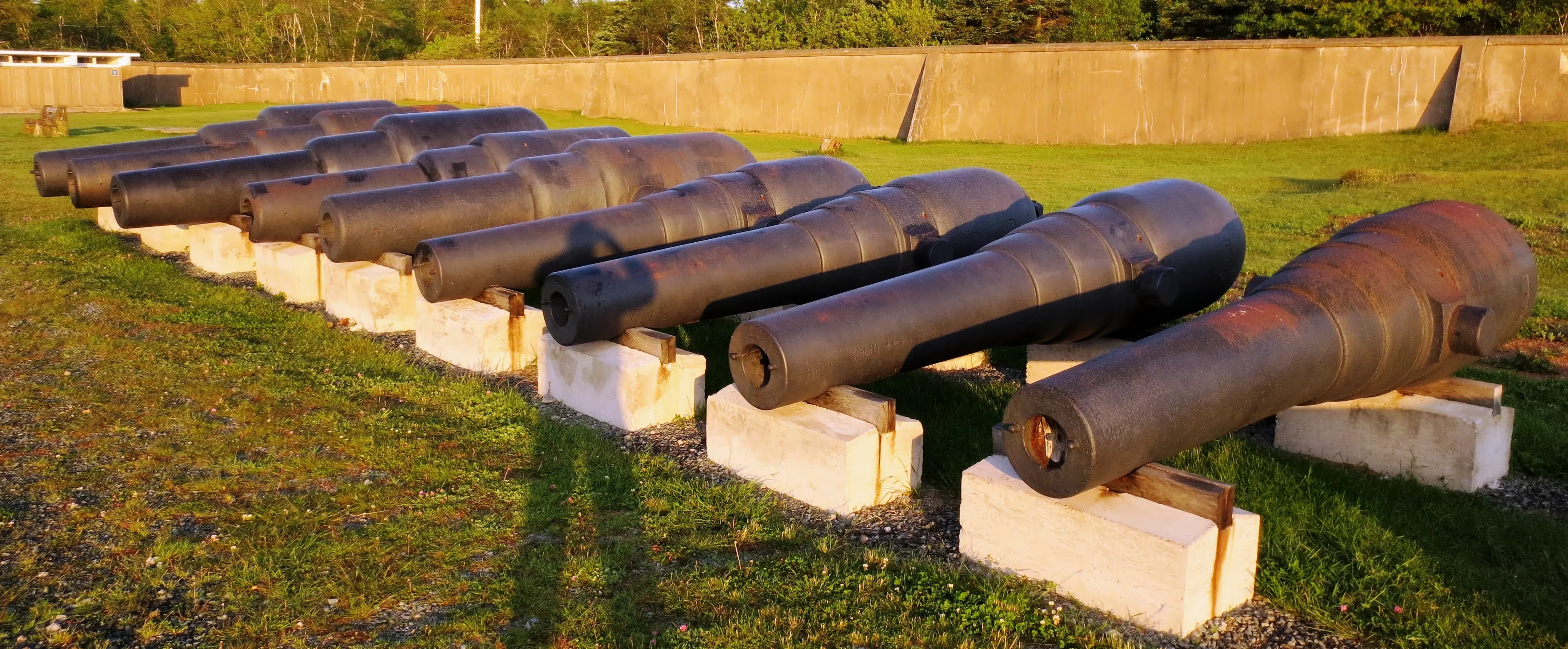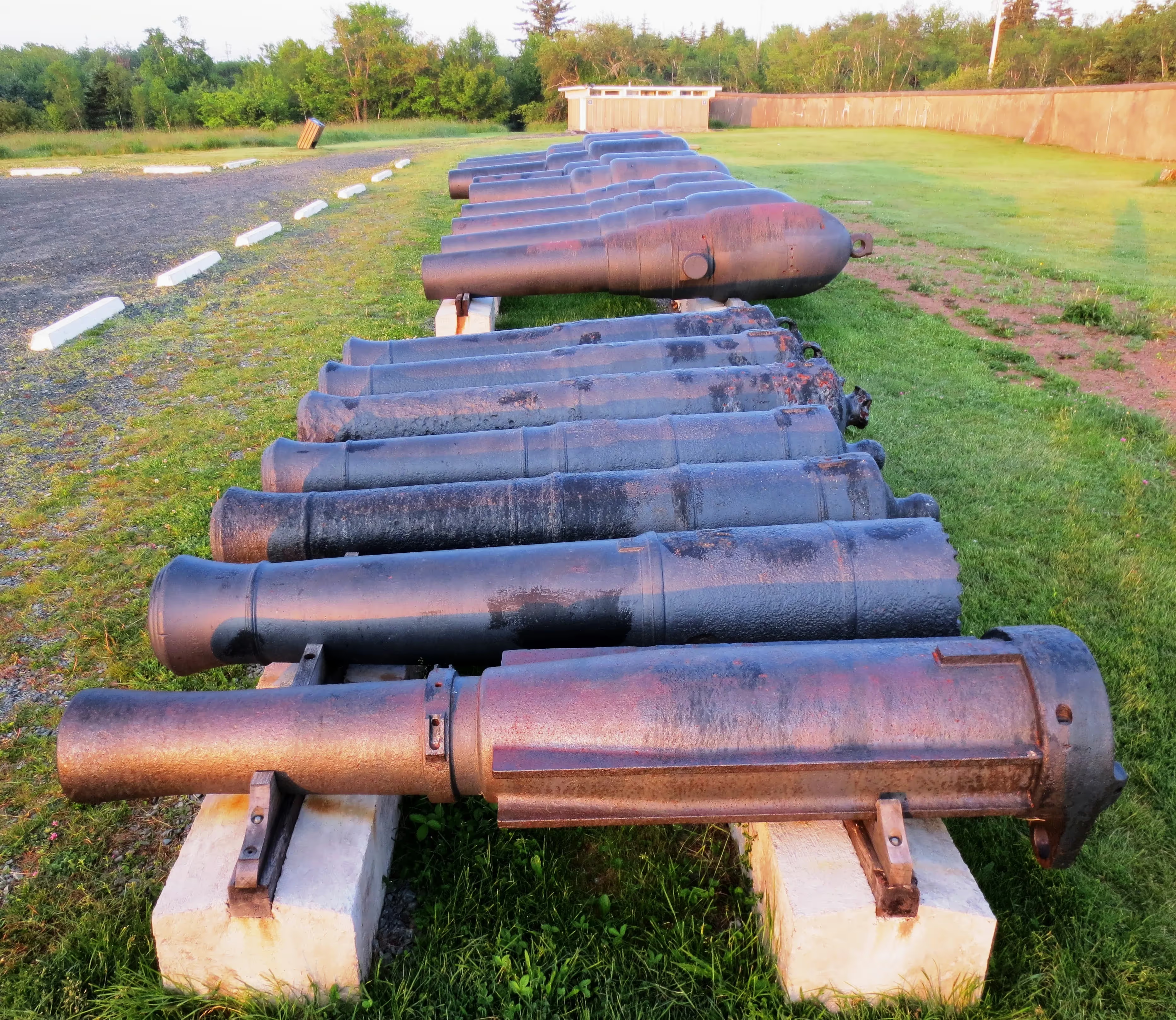Artillery in Canada (9) Nova Scotia: Halifax, York Redoubt
York Redoubt
The aim of this website is to locate, identify and document every historical piece of artillery preserved in Canada. Many contributors have assisted in the hunt for these guns to provide and update the data found on these web pages. Photos are by the author unless otherwise credited. Any errors found here are by the author, and any additions, corrections or amendments to this list of Guns and Artillery in Canada would be most welcome and may be e-mailed to the author at [email protected].
For all official data concerning the Royal Regiment of Canadian Artillery, please click on the link to their website:
Royal Regiment of Canadian Artillery Website
Note: Back in the day, artillery in Canada was referred to by its radio call sign "Sheldrake". It is now referred to by its "Golf" call sign. (Acorn sends)
The web page for Nova Scotia has become too big for all the guns to be listed on one page, therefore the guns on display within Annapolis Royal including Fort Anne, the City of Halifax including York Redoubt, the Fort George Citadel, the Maritime Command Museum and Royal Artillery Park etc., are listed on separate pages for Nova Scotia.
Halifax, York Redoubt
%2520-%2520Copy.avif)
York Redoubt plaque.

There are five 9-inch 12-ton Muzzleloading Rifles and one 10-inch 18-ton Muzzleloading Rifle mounted and well preserved in the coastal battery at York Redoubt National Historic Site near Halifax. The 9-inch guns fired a projectile of 256 pounds (116 kg.) at an effective range of 2,000 yards (1829 m.). Great guns such as these were installed in major Canadian forts from the 1860s. During the 1880s, the eight forts defending Halifax had thirty-eight 9-inch (22.8 cm.) guns as well as fifteen 10-inch (25.4 cm.), fifteen 7-inch (17.7 cm.) and nine 64-pounder (29 kg.) Muzzleloading Rifles set in place to defend the city against enemy warships. The mountings and the concrete ‘Moncrieff’ emplacement pit, named after its designer, were a refinement of the 1890s which allowed the gunners to fire the gun over a high parapet while being well protected from enemy fire. (Parks Canada)
York Redoubt diagram of artillery on site.


The five 9-inch 12-ton Muzzleloading Rifles and one 10-inch 18-ton Muzzleloading Rifle mounted on the ramparts of York Redoubt are numbered from one to six, right to left, standing behind them facing North:









(Author Photos)
No. 1. 9-inch 12-ton Mk. III Muzzleloading Rifle, weight 12-13-0-0, (28,336 lbs), (RGF No. 374, III, 1869) on left trunnion, (+) on right trunnion, Queen Victoria cypher, mounted on an iron traversing carriage.








(Author Photos)
No. 2. 10-inch 18-ton Mk. II Muzzleloading Rifle, weight 17-17-0-0, (RGF No. 75, II, 1870) on left trunnion, (+) on right trunnion, Queen Victoria cypher, mounted on an iron traversing carriage. An English ton is 2,240 lbs, therefore the weight for this gun is (17 X 2,240 lbs = 38,080 lbs) + (17 X 112 lbs =1904) = 39,984 lbs or close to 20 tons in Canadian weight.








(Author Photos)
No. 3. 9-inch 12-ton Mk. III Muzzleloading Rifle, 1869, weight 12-13-3-0, (28,420 lbs), (RGF No. 361, III, 1869) on left trunnion, (+) on right trunnion, Queen Victoria cypher, mounted on an iron traversing carriage.









(Author Photos)
No. 4. 9-inch 12-ton Mk. III Muzzleloading Rifle, weight 12-13-2-0, (28,392 lbs), (RGF No. 380, III, 1869) on left trunnion, (+) on right trunnion, Queen Victoria cypher, mounted on an iron traversing carriage.










(Author Photos)
No. 5. 9-inch 12-ton Mk III Muzzleloading Rifle, weight 12-12-3-0, (28,308 lbs), (RGF No. 354, III, 1869) on left trunnion, (+) on right trunnion, Queen Victoria cypher, mounted on an iron traversing carriage.




(Author Photos)
No. 6. 9-inch 12-ton Mk III Muzzleloading Rifle, weight 12-13-2-0, (28,392 lbs), (RGF No. 298, III, 1869) on left trunnion, (+) on right trunnion, Queen Victoria cypher, mounted on an iron traversing carriage.
There are 17 unmounted Guns, with one row of nine in large calibres, a second row of seven in smaller calibres and one Cast Iron 12-pounder Smoothbore Muzzleloading Gun with broken trunnions beside one of the park signs, all resting on wood blocks inside York Redoubt. Most of these guns are heavily corroded with only partial details and serial numbers discernible

(Author Photo)
Cast Iron 12-pounder Smoothbore Muzzleloading Gun, weight 29-0-2 (3,270 lbs), 7-feet, 6-inches long, cast during the reign of King George III (1760-1820). This gun has broken trunnions and rests on wood blocks near the line of six mounted RML Guns on the ramparts. David McConnell, British Smooth-Bore Artillery: A Technological Study, (Ottawa, Minister of Supply and Services Canada, 1988), p. 83.

(Author Photos)
Large row of nine guns, right to left:



(Author Photos)
No. 1. 10-inch 18-ton Mk. II Muzzleloading Rifle, weight 17-18-2-0 (40,152 lbs), RGF No. 46, 1870 on the left trunnion, Queen Victoria cypher, Firths Steel (Serial No. 1921) on the muzzle face.
No. 2. 10-inch 18-ton Mk. II Muzzleloading Rifle, weight 17-19-1-0 (40,236 lbs), RGF No. 38, 1870 on the left trunnion, Queen Victoria cypher, Firths Steel (Serial No. corroded) on the muzzle face.



No. 3. 10-inch 18-ton Mk. II Muzzleloading Rifle, weight 18-0-0-0 (40,320 lbs), RGF No. 72, 1870 on the left trunnion, Queen Victoria cypher, Firths Steel (Serial No. 1901) on the muzzle face.


(Author Photos)
No. 4. 9-inch 12-ton Mk V Muzzleloading Rifle, weight 12-0-0-0 (26,880 lbs), RGF No. 650, 1877. Firths Steel 46. A three foot long portion of approximately ¼ of the gun barrel has been cut from this gun. 47 stamped on the side of the gun.
No. 5. 9-inch 12-ton Mk III Muzzleloading Rifle, weight corroded (>26,000 lbs), RGF No. corroded. Firths Steel (Serial No. corroded) on the muzzle face.


(Author Photos)
No. 6. 7-inch 7-ton Mk. I Muzzleloading Rifle, weight 7-2-1-18 (15,950 lbs), corroded, RGF No. 29, 1866, Firths Steel (Serial No. 205) on the muzzle face. Queen Victoria cypher.


No. 7. 7-inch 7-ton Mk. I Muzzleloading Rifle, weight 7-2-1-0 (15,932), RGF No. 12, 1866, Queen Victoria cypher, Firths Steel (Serial No. 207) on the muzzle face.


(Author Photo,
No. 8. 7-inch 7-ton Mk. I Muzzleloading Rifle, weight 7-2-3-0 (15,988 lbs), RGF No. 30, 1866, Queen Victoria cypher, Firths Steel (Serial No. 199) on the muzzle face.





No. 9. 7-inch 7-ton Mk. I Muzzleloading Rifle, weight corroded (>15,000 lbs), RGF No. corroded, Queen Victoria cypher, Firths Steel (Serial No. corroded) on the muzzle face.

(Author Photos)
Small Row of seven guns, right to left:
No. 1. Cast Iron 12-pounder Smoothbore Muzzleloading Gun, weight corroded, 5, King George III cypher, ca. 1780.
No. 2. Blomefield Cast Iron 12-pounder Smoothbore Muzzleloading Gun, King George III cypher, heavily corroded.
No. 3. Blomefield Cast Iron 12-pounder Smoothbore Muzzleloading Gun, King George III cypher, heavily corroded.
No. 4. Cast Iron 12-pounder Smoothbore Muzzleloading Gun, 8-feet, 6-inches long, weight 29-0-0 (3,248 lbs), King George III cypher, ca. 1780.
No. 5. Cast Iron 12-pounder Smoothbore Muzzleloading Gun, 8-feet, 6-inches long, weight 29-3-7 (3,339 lbs), King George III cypher, ca. 1780.
No. 6. Cast Iron 12-pounder Smoothbore Muzzleloading Gun, weight 29-0-22 (3,270 lbs), 14, King George III cypher, ca. 1780, cascabel portion has been cut off.



%2520-%2520Copy.avif)
No. 7. 6-inch 30-cwt Breechloading Mk. I Howitzer. The number 90 is stamped on the barrel, remaining data is too heavily corroded to decipher. There were six of these howitzers on record in Canada, including Serial Nos. 132, 134, 138, 141, 106 and 107. Canada ordered two of these howitzers from Vickers in 1901 and four were taken over from the British in 1906. Four were shipped back to the UK in 1915, the remaining two were to be scrapped in 1922. This is the only one remaining.

(David Holt Photo)
6-inch 30-cwt Breechloading Mk. I Howitzer mounted on a wheeled carriage in the Imperial War Museum, London, UK.





